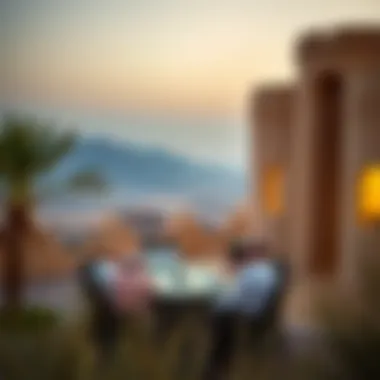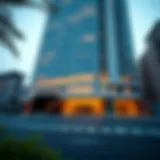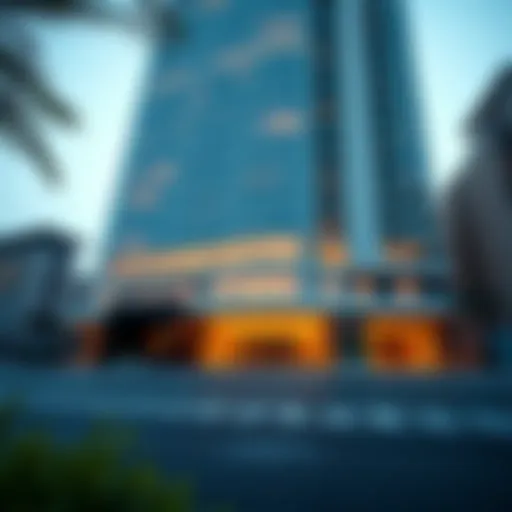Traveling from Dubai to Ras Al Khaimah: A Complete Guide


Intro
Traveling from Dubai to Ras Al Khaimah is more than just a trip; it’s an opportunity to experience the rich tapestry of landscapes, culture, and heritage that the UAE has to offer. As the bustling metropolis of Dubai gives way to the serene expanse of Ras Al Khaimah, travelers embark on a journey that showcases not just the iconic skylines but also the rugged mountains and picturesque coastlines that characterize this northern emirate.
Understanding the routes, modes of transport, and highlights along the way plays a crucial role in enhancing your travel experience. This guide aims to offer insights into planning your journey, whether you're driving yourself, opting for public transport, or looking for other convenient ways to make the trip.
While exploring the landscapes, one can appreciate the stark contrasts between the two emirates. Dubai, known for its ultramodern architecture and luxury lifestyle, serves as a busy hub where east meets west. In contrast, Ras Al Khaimah embodies a different charm with its laid-back atmosphere, natural beauty, and a strong cultural feel.
A thorough understanding of this route is essential for discerning travelers looking to make the most of their time in the UAE. From hidden gems along the highway to breathtaking views and cultural landmarks, this journey offers numerous opportunities to immerse oneself in the local way of life.
Whether you are a real estate investor eyeing new opportunities, a developer in search of the next big project, or simply a curious traveler, there is much to discover along this well-trodden path. So buckle up, as we navigate through the various facets of making this journey from the dazzling urban sprawl to the tranquil beauty of Ras Al Khaimah.
Understanding the Geography
The geography of any region plays a pivotal role in shaping its culture, economy, and travel opportunities. When exploring the route from Dubai to Ras Al Khaimah, understanding the geographical nuances is particularly crucial for travelers and investors alike. The landscape between these two emirates offers various insights that can heighten one’s experience, whether it's in a recreational capacity or for potential real estate investments.
Given that Ras Al Khaimah is situated in the northern part of the UAE, the transition from Dubai—a bustling urban hub—into its more tranquil counterpart reveals contrasts that are not only geographical but also cultural. This journey isn't just about the miles traveled; it’s a passage through diverse terrains, each holding significance both historically and currently.
Topographical Overview
The topography along the route from Dubai to Ras Al Khaimah is expressively varied, essentially reflecting the convergence of urban development and natural landscapes. The drive generally spans around 113 kilometers with a landscape that transitions from the shimmering structures of Dubai to the rugged landscapes that characterize Ras Al Khaimah.
On one side, the architectural marvels of Dubai rise like giants, showcasing human achievement amidst wide sandy expanses. As one travels further, low mountains and undulating hills emerge, particularly as they approach Ras Al Khaimah, accentuating the stark beauty of nature juxtaposed with modernity. In this geographic mash-up, travelers can witness clusters of date palms, stretches of arid desert, and the crystal clear waters of the Arabian Gulf.
A notable geographical component is the Hajar Mountains that border Ras Al Khaimah to the east. These mountains not only add a scenic backdrop but also provide a sense of place, influencing climate patterns and biodiversity. Their presence is integral to the emirate, affecting local weather, water availability, and even agricultural activities.
Significant Landmarks Along the Route
The journey from Dubai to Ras Al Khaimah is sprinkled with significant landmarks that capture the rich tapestry of the area’s history and culture.
- Sharjah: Before reaching Ras Al Khaimah, a short detour through Sharjah reveals the cultural heart of the UAE. It is renowned for its museums and vibrant arts scene. Visitors should not miss the Sharjah Arts Museum and the heritage area, rich with history and local craftsmanship.
- Al Hamra Village: This charming waterfront community reflects the modern lifestyles being developed in the emirate, showcasing residential real estate options and leisure facilities. Investors may find it a noteworthy spot for opportunities.
- Iceland Water Park: Parked along the way, this family-friendly destination provides a refreshing stop. It highlights the blend of leisure and adventure that characterizes the UAE's approach to tourism.
- Mangrove Forests: Near Ras Al Khaimah, the mangroves offer ecological significance. They are vital for biodiversity and can appeal to nature lovers and ecological enthusiasts alike.
Travelers should take note that these landmarks provide both cultural depth and visual spectacles, ultimately enriching their journey.
Understanding the geography of the route enables potential visitors and investors to grasp the basin of lifestyle options awaiting them in Ras Al Khaimah, all while fostering a deeper appreciation for the contrasts and commonalities shared with Dubai. For more geographical insights, you may refer to sources such as Britannica, and the local governmental insights provided on UAE.gov.
"The journey of a thousand miles begins with one step" - a reminder that understanding the geography is the first step in fully experiencing the beauty this route offers.
Modes of Transportation
When it comes to exploring the route from Dubai to Ras Al Khaimah, understanding the various modes of transportation is essential. Each option offers a unique experience, accessibility, and benefits tailored to different travel needs. Whether one prefers the freedom of driving, the convenience of bus services, or the ease of taxis and rideshares, knowing the available choices can make all the difference in planning an enriching journey.
Driving
Driving from Dubai to Ras Al Khaimah grants an unparalleled sense of liberation. The distance between the two cities is roughly 120 kilometers, and the drive typically takes around 1.5 to 2 hours, depending on traffic. The route is straightforward, primarily following the E311 highway, which is well-maintained and marked.
For those wanting to take scenic detours, the road provides chances to glimpse the desert landscape and perhaps spot some camels grazing near the roadside. Just keep your eyes peeled; some areas can be surprisingly serene, offering a contrast to the bustling urban life of Dubai.
Benefits of driving include:
- Flexibility to stop at various points of interest along the way.
- The ability to travel on your own schedule without being bound by public transport timetables.
- Convenience, especially for families or groups with luggage.


However, potential drivers should also consider the traffic patterns, toll costs, and details on parking availability in Ras Al Khaimah, which may vary in urban and tourist-heavy areas. Always be cautious of high-speed limits and local driving regulations to ensure a safe and enjoyable trip.
Bus Services
For travelers seeking a budget-friendly option, bus services offer a practical alternative to private transport. The main operator, Dubai’s Roads and Transport Authority (RTA), provides a reliable service connecting the two emirates.
Most buses depart from major terminals in Dubai and reach Ras Al Khaimah in approximately 2 to 2.5 hours. These air-conditioned buses are equipped with comfortable seating, making the journey pleasant. Buses typically run on an hourly schedule, which adds to their convenience.
Bus travel also allows for a chance to mingle with locals and other travelers, providing a richer cultural experience. Travelers should plan to purchase tickets in advance, as they can sell out, especially during peak tourist seasons.
Taxi and Ride-Sharing Options
Opting for taxis or ride-sharing services like Careem and Uber can be particularly advantageous for short visits. These services offer the comfort of a direct point-to-point ride without the hassles of driving. While pricier than buses, taxi fares are still reasonable when splitting costs among several passengers.
A taxi ride from Dubai to Ras Al Khaimah typically costs between AED 300 to AED 400, depending on traffic and your exact pickup and drop-off points. Using a ride-sharing app provides an added layer of convenience, where users can easily request rides from their smartphones, track their driver’s location, and receive fare estimates beforehand.
Key considerations when using taxis or rideshares include:
- Greater convenience and less planning compared to driving or navigating bus schedules.
- Ability to kick back and enjoy the views without worrying about road stress.
- Ensure that the driver understands your destination clearly to prevent misunderstandings.
Tourist Transport Options
For tourists keen on exploring, numerous companies offer specialized transport options, such as guided tours or customized packages. These can range from luxury coaches to chauffeur services that include additional amenities like refreshments or guided insights into the history and culture of the places visited.
Taking a tour provides more than just transportation; it often incorporates stops at prominent landmarks or historical sites, enriching the overall experience. Some tourist firms even arrange activities along the way, such as desert safaris or guided nature walks.
Additionally, groups or families might find that these services offer the ease of managing everyone’s schedule seamlessly, as they can tailor the itinerary to suit specific interests.
"Choosing the right mode of transportation is vital for ensuring a smooth journey. Each option has its unique perks and potential pitfalls, so be sure to assess what fits your travel style best."
In summary, whether it's the independence of a personal vehicle, the affordability of bus rides, the simplicity of taxis and ride-shares, or the guided experiences offered by tourist transport options, travelers have a myriad of choices to tailor their journey from Dubai to Ras Al Khaimah. Understanding these modes of transport allows for an informed choice, enhancing the exploratory adventure in the UAE.
Travel Times and Distances
Understanding travel times and distances when journeying from Dubai to Ras Al Khaimah is essential for effective planning, especially for prospective visitors who wish to maximize their experience in the UAE. This region, known for its contrasting urban landscapes and serene natural beauty, is best explored with a solid grasp of how long it takes to get from one place to another. Knowing the approximate travel durations can help travelers decide on their itineraries, manage their time wisely, and even influence their choice of transport methods.
Insights into travel times also help real estate agents, investors, and tourists alike assess the accessibility of Ras Al Khaimah’s attractions. For instance, a shorter travel time could mean more opportunities for exploration and enjoyment of cultural sites, while a longer journey might warrant overnight stays. Thus, understanding the logistics of travel in this part of the UAE is a significant step toward an enriching experience.
Average Driving Time
The drive from Dubai to Ras Al Khaimah typically spans approximately one hour and 15 minutes under normal traffic conditions. The distance is around 113 kilometers, making it an achievable trip for anyone visiting the emirate. However, traffic patterns, particularly during peak periods, can significantly alter this average. Weekends and public holidays often see an influx of individuals heading to Ras Al Khaimah, resulting in longer travel times.
For instance, if you’re hitting the road on a Friday afternoon, it’s wise to allot extra time, perhaps an additional 30 minutes or more. The route itself meanders through a mix of urban areas and picturesque desert landscapes, providing a visual feast along the way. Therefore, it’s not just about the destination; the journey holds its charm, inviting travelers to consider scenic pit stops or quick detours for photography.
Public Transport Duration
Public transport is another viable option for those traveling from Dubai to Ras Al Khaimah. Buses offer a cost-effective means of transportation, generally taking about two hours to make the trip, depending on the route and the number of stops. For instance, taking the E-400 bus, one of the most popular routes, you can expect a journey filled with diverse landscapes and local flavor.
Being aware of bus schedules is crucial; buses don’t run as frequently as cars might be available for rental. Schedule your journey ahead of time, especially during busy seasons when demand peaks. Alternatively, ride-sharing services can sometimes offer faster routes depending on traffic and passenger load, adding a layer of convenience for those who prefer a more private experience.
Overall, understanding travel times and distances between Dubai and Ras Al Khaimah can greatly influence how visitors experience both locations, encouraging them to explore more and discover the hidden gems along their route.


Cultural Significance
Understanding the cultural significance of Ras Al Khaimah enriches the journey from Dubai. This emirate, often overshadowed by its more famous neighbor, has a rich tapestry of history and modernity that intertwines to tell a compelling narrative. Embracing the cultural elements allows travelers to go beyond mere sightseeing; it fosters a connection to the people, traditions, and the very essence of Emirati life. Visitors who take time to explore both historical and contemporary aspects of Ras Al Khaimah engage with the local heritage, promoting appreciation and respect for the culture.
Historical Context of Ras Al Khaimah
Ras Al Khaimah's history is a treasure trove waiting to be explored. Known as the birthplace of the UAE, this emirate's history stretches back thousands of years. In ancient times, it served as a significant trade hub due to its strategic location along maritime routes.
Archaeological sites like the Al Jazirah Al Hamra and the Dhayah Fort serve as reminders of the region's vibrant past. Al Jazirah Al Hamra, for instance, is a well-preserved ghost town, offering a glimpse into life before the discovery of oil. Its crumbling coral stone buildings and abandoned alleyways echo stories of the past.
The strategic significance of Ras Al Khaimah was evident during the conflicts of the 19th century, particularly with British colonial interests lingering over the Gulf region. The emirate's resilience during these times contributed to its identity. Historical figures like Sheikh Sultan bin Saqr Al Qasimi, who ruled in the 19th century, played a significant role in fortifying the emirate’s defenses and preserving its independence.
In essence, the historical context of Ras Al Khaimah is interlaced with both struggle and triumph, forming an essential background for understanding its present circumstances.
Modern Developments in the Region
Fast forward to the present day, and Ras Al Khaimah has undergone a remarkable transformation. The emirate is now recognized for its booming tourism industry, impressive infrastructure, and strategic development plans. The government is focused on diversifying the economy, reducing reliance on oil by promoting sectors like tourism, manufacturing, and renewable energy.
One notable development is the RAK Economic Zone, which has attracted numerous investors and businesses. This zone offers attractive incentives for foreign investment, further fueling the region's economy. The growth of luxury resorts along the stunning coastline caters to tourists seeking relaxation and adventure alike, making Ras Al Khaimah a prime destination in the UAE.
Moreover, cultural initiatives such as the RAK Museum and various art festivals seek to preserve local culture while promoting modern artistic expression. These venues celebrate Emirati customs and encourage new forms of creativity!
Understanding both the old and new facets of Ras Al Khaimah is crucial for appreciating its rich heritage and modern aspirations.
For further reading about Ras Al Khaimah history, check Wikipedia or Britannica.
Touristic Attractions in Ras Al Khaimah
Ras Al Khaimah (RAK) is a treasure trove of experiences, drawing in travelers with its mix of natural beauty and rich heritage. Understanding the touristic attractions here is crucial for making the most out of a visit. From breathtaking landscapes to significant cultural landmarks, exploring these attractions can deepen your appreciation of this emirate and make any journey between Dubai and Ras Al Khaimah truly memorable.
Natural Wonders
The emirate boasts stunning natural landscapes, reflecting both tranquility and adventure. One of the prominent features is Jebel Jais, the highest mountain in the UAE. This majestic peak not only offers breathtaking panoramas but is also home to the world's longest zip line. Adventurers often flock here to experience the thrill of soaring across the rugged terrain.
The picturesque Al Hamra Beach is another gem, where visitors can indulge in various water sports or simply relax under the sun. This stretch of coast is not just a spot for leisure; it serves as a backdrop for various beachside investments, reflecting the emirate's growing appeal as a tourist destination.
Furthermore, nature enthusiasts should not miss out on Wadi Bih. This lush oasis showcases the region’s unique flora and fauna. Hiking and exploring the wadi provide a glimpse into the natural ecosystems of the area, making it a worthwhile stop for both families and adventure seekers.
Cultural Heritage Sites
Delving into the cultural heritage of Ras Al Khaimah unveils a rich tapestry of history. The National Museum of Ras Al Khaimah offers insights into the emirate’s past, featuring artifacts that date back to the pre-Islamic era. This museum stands as a testament to the region's enduring story, displaying archaeological finds that highlight its historical significance.
Another cornerstone of RAK’s heritage is the Sheikh Zayed Palace, once the royal residence. It exemplifies traditional Emirati architecture and is a reminder of the emirate's royal history. Visitors can explore its many rooms while enjoying the serene gardens that envelop the palace.
Lastly, the Dhayah Fort is an iconic site that overlooks the surrounding landscape. Its strategic position made it an essential stronghold in times of conflict. Today, it serves as a symbol of resilience and heritage, inviting tourists to walk through history.
Exploring these attractions is not just about the sights; it’s about immersing oneself in the lifestyle and traditions of the emirate.
Practical Travel Tips
When embarking on a journey from Dubai to Ras Al Khaimah, understanding practical travel tips can greatly enhance your overall experience. These insights not only help in navigating the unique landscape but also ensure that your trip is smooth and enjoyable. Travellers who arm themselves with knowledge regarding the best times to visit, local customs, and safety precautions often find themselves better equipped to embrace the rich tapestry of culture and amenities that this route offers.


Best Times to Visit
The timing of your visit to Ras Al Khaimah plays a pivotal role in the quality of your experience. Given the arid desert climate, the ideal window for travel falls between mid-October and early April. During these months, temperatures are comfortably warm, ranging between 24°C to 28°C, making it quite suitable for outdoor activities and exploration.
Visiting during Ramadan presents a unique opportunity to witness the cultural practices, though be mindful of fasting hours which might affect dining options.
Average daytime highs in summer can soar over 40°C, which is less optimal for many outdoor pursuits. Hence, it is advisable to plan your itinerary within the cooler months to enable fully embracing the region's offerings without being bogged down by the heat.
Dress Code and Local Customs
Ras Al Khaimah, while more relaxed than some other emirates, still maintains a strong adherence to local customs, which should be respected by visitors. Proper attire, especially in public places, is generally expected to be conservative. For both men and women, covering the shoulders and knees is a good standard to follow. Swimwear should be confined to the beach or pool areas only.
Food and dining habits can also reflect cultural norms. It is polite to wait for a local to start eating before enjoying your meal, and trying local dishes can endear you to the residents.
- Customs to Keep in Mind:
- Avoid public displays of affection.
- Refrain from discussing sensitive topics such as politics.
- When greeting, a handshake is common in business settings, but be cautious with the opposite gender.
Safety Considerations
While Ras Al Khaimah enjoys a reputation for safety, it’s always prudent to take precautionary measures. As with any travel destination, exercise standard caution.
- Some essential safety tips include:
- Always be aware of your surroundings, particularly in crowded areas.
- Keep your belongings secure and avoid displaying valuables.
- Register with your embassy if you plan on staying for an extended period.
It is also wise to familiarize yourself with emergency contact numbers, which can be a boon in case of unforeseen mishaps. The local police and emergency services can be reached easily, and many locals are more than willing to assist a tourist in need.
"Preparation, indeed, makes for a better adventure. Navigating the roads in Ras Al Khaimah with foresight can lead to experiences that are unforgettable!"
Equipping yourself with these practical travel tips sets the stage for a gratifying journey. This ensures that both Dubai’s vibrancy and Ras Al Khaimah’s charm can be appreciated without unnecessary hiccups. Taking note of the right timing, cultural etiquette, and safety protocols not only showcases respect towards the local lifestyle but also enhances your scoring as a savvy traveler.
Finale: Integrating Dubai and Ras Al Khaimah
The journey between Dubai and Ras Al Khaimah is more than just a trip; it represents a merging of two cultures and landscapes, each with its unique charm and characteristics. Understanding this connection is pivotal for anyone looking to invest or engage with the real estate markets or tourism sectors in the UAE.
The Overall Experience
Traveling from Dubai to Ras Al Khaimah isn't just about the physical distance; it’s about the transformation in environment and atmosphere. As one traverses from the bustling urbanity of Dubai to the serene landscapes of Ras Al Khaimah, visitors experience a shift not only in scenery but also in cultural nuances.
This transition can be likened to changing valleys while hiking through a range of mountains. Both locations, while part of the same nation, offer contrasting experiences that can appeal to diverse interests. For real estate agents and investors, recognizing these differences is crucial. Investments in properties, whether for tourism or residential purposes, greatly benefit from a thorough understanding of what each emirate has to offer.
Moreover, the abundance of archaeological and cultural sites in Ras Al Khaimah invites a rich narrative that can be exploited for tourism development. Connective cultural events, such as heritage festivals held in Ras Al Khaimah, can attract visitors from not just Dubai but from broader regions, enhancing the economic synergy between the two emirates.
Future Development and Connectivity
Looking forward, the integration of Dubai and Ras Al Khaimah will likely evolve further, chiefly driven by infrastructure advancements. The upcoming projects, such as improved roadways and potential rail links, are poised to transform travel times. Predictions indicate that with better connectivity, the tourism flow will spike, providing ample opportunities for those within real estate and development fields.
Additionally, developers should keep an eye on the increasing demand for properties in Ras Al Khaimah due to its appeal as a getaway from the bustling life of Dubai.
Here are key takeaways to consider:
- Enhanced Connectivity: Future roads and potential rail links will shrink the division between the two emirates.
- Property Demand: Increasing travelers seeking investment opportunities in less urban settings will fuel real estate growth.
- Cultural Events: Joint cultural promotions can attract a wider audience, benefiting both emirates economically and socially.
The synergy created between Dubai and Ras Al Khaimah speaks volumes about the region's potential in a global context. As one navigates down this route, there exists an unspoken promise of growth—growth that is not only required but also inevitable as both areas continue to rise in prominence on the world stage.
"Two places, different stories, yet intertwined futures."
As the journey along this route unfolds, it fosters a connection that transcends simple geography, inviting both visitors and investors to discover the full extent of what the UAE offers.











